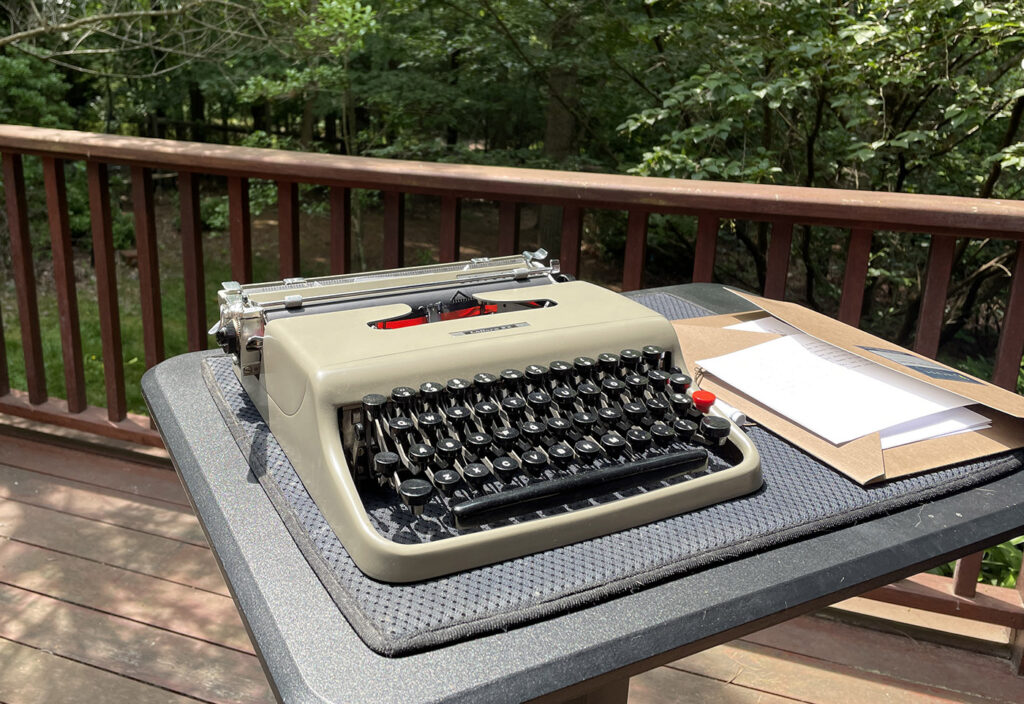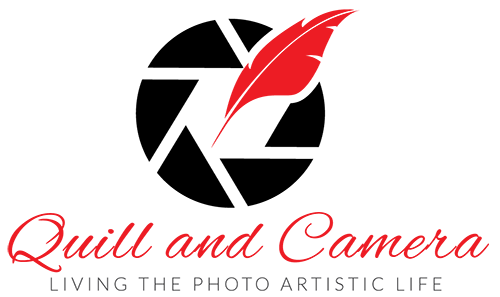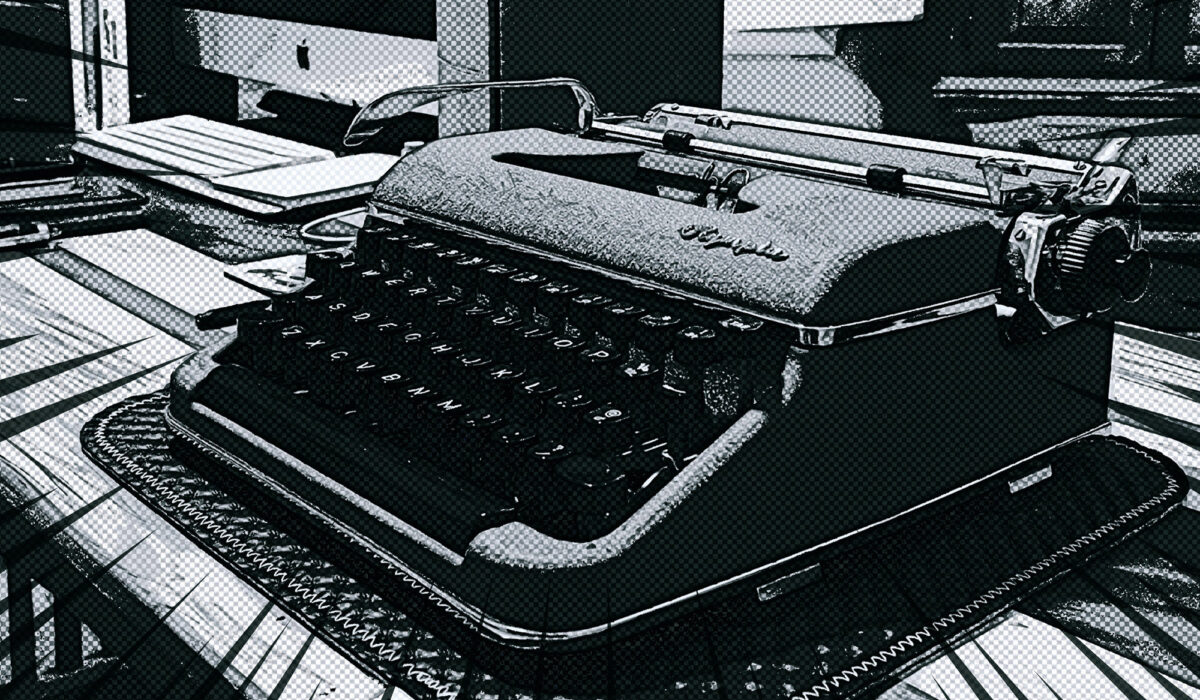— As digital artists it’s easy to take up life inside our computer screens and never come out again. But maybe there’s something analog tools in the real world can still teach us.

Some time back, inspired by the book The Typewriter Revolution, I acquired three manual typewriters. By coincidence, all three were from 1958: the best a fully refurbished Olympia SM3 DeLuxe (this one is in my office), but also a well-preserved Smith Corona Silent Super (for the library / reading room) and an ultra-portable Olivetti Lettera 22 (which I like to take out on the back deck and to local parks and coffee shops).
Now, I’ve long been a proponent of taking up journal and pen in the interest of cooking up creative ideas for photo shoots and compositions. There’s also no better way, to my thinking, of dreaming up ideas for how you might carry your artwork off the screen and out into the real world. Whether you’re dreaming up a book idea in which your art will serve as illustration … or fleshing out an imaginative idea for an exhibition of your work … putting pen to paper can be one of the best approaches possible.
Why? Because when it’s just you and a notebook, all you have is your imagination.
By stepping away from the endless potential distractions waiting to waylay you on your computer you’re actually able to think, imagine, dream.
And this was one of the reasons I took up a typewriter again. When it’s just you and a piece of paper and the rat-a-tat of the keys (and the delightful ding of the bell at the end of each line), something magic happens. No distractions, no notifications, no pop-ups … but also no copy/paste, no spell-check, no sidestepping into a browser to look stuff up.
And best of all: No endless fiddling or constant re-writing as you go.
That might be the most important advantage of a typewriter. It’s just you and your ideas and the page in front of you filling up in a headlong rush of inspiration.
In the end you have a page of text (a page of your own thoughts and ideas) uncorrupted by detours into social media, your inbox, or YouTube. And what you typed — similar to what you might write in your journal — exists only there, on that page in front of you.
Now, how might this translate to the way you work with Photoshop? Glad you asked!
Beyond being a simple reminder to periodically take up some kind of analog tool to explore your creative ideas away from the computer, I think there are three takeaways worth translating over to your time spent working at your photo artistry:
1.) Just as a typewriter encourages an intentional approach to putting down words without fiddling with them when you ought to be simply getting your ideas out . . . Now and then you should consider taking up your camera and treating it as if it were loaded with film. (I created a whole short course on this: “Shooting Digital LIKE FILM.”) This means, in effect, pretending to yourself that your digital camera is loaded with a particular kind of film with a specific number of exposures you’re able to capture, and where you force yourself to become more thoughtful and intentional with each photo you create, not even allowing yourself to peek at the preview until you get back home and “develop” the images when you open them in a program like Lightroom.
2.) Just as a typewriter provides you with a distraction-free writing environment . . . You should absolutely do what you can to tidy up your desktop (on your computer and in the real world) so as to remove the clutter (digital and otherwise) that might otherwise tug at your mind and threaten to interrupt your Muse. (This kind of tidying up is one of the key steps I include in my “21 Days to Creative Abundance.”) If you’re going to sit down to work on a piece of art in Photoshop, consider hiding any browsers, shutting down any social media, turning off any notifications, even leaving your phone in another room. Shut out everything else by treating Photoshop as a single function device and simply lose yourself in the creative process.
3.) And just as the finished page produced from a typewriter is in that instant a one-of-a-kind document connected to nothing and no one but you, existing no where else in the universe (something you can file away or easily crumple up and toss if you don’t like it) . . .
I encourage you to treat your Photoshop compositions in the same way: as you create them initially, let them exist only there, only for YOU. Too often we create as if with the entire world (or at least everyone we know on Facebook) leaning over our shoulder. Even as we sit there at work we’re already worried about what others will think about it. We’re already wondering whether or not someone will “Like” it. But this is no way to create something fresh and exciting and new! This is no way to take chances and push beyond our previous limits. So imagine yourself at a typewriter instead. No one need ever see what you’re working on. You can experiment. You can get as creative, as artsy, as outright messy as you want! Try something new. Have some FUN. Expect to fill some canvases with art you’ll never share with anyone, artwork you might file away never to be seen again. Go into it with the idea of creating first drafts — artwork you might later pull ideas from and carry over to fresh new canvases. And only think of sharing them when those ideas and experiments come together in ways that excite you, and only when you can’t help but share them.
I often find myself reminding new artists “What you’re working on right now doesn’t have to be for keeps. Right now you’re just learning the ropes. It’s okay to just PLAY. Stop worrying so much about what others will think, and stop worrying so much about creating a masterpiece every time you open Photoshop. Just CREATE and see where it takes you.”
That’s a bit of advice every artist needs to be reminded of from time to time. No matter how experienced.
This is why I think a return to our analog roots — even if only in the way we approach our art, by removing distractions and disconnecting us from the concerns of social media and our endless worries about what others will think — can help us become more intentional (and more cheerful) creative artists.
Perhaps what I’ve described here amounts to a sort of mental trick we play on ourselves, a bit of pre-digital / pre-Photoshop time-travel.
But if it works, why not?
Think of it as just one more way of re-awakening the Muse. A way of saying to ourselves, “It’s safe here. Just have some fun.”
And here’s an assignment for you — a bit of analog creative exploration to get you started on this path:
Go grab a pen and notebook, sit down with a cup of tea or whatever you like, and spend the next 15 minutes writing down some ideas for how you might make your creative work more fun. What’s something you could do at the start of the process (image-gathering), something new you could experiment with while in Photoshop as you work on the canvas, and something cool you could do afterward with a print you make of the finished piece?
Get creative. Dream a little.
Revisit your analog roots . . . take up a simple pen and paper (or a typewriter) . . .
There’s still some magic to be found there.
~ Sebastian

